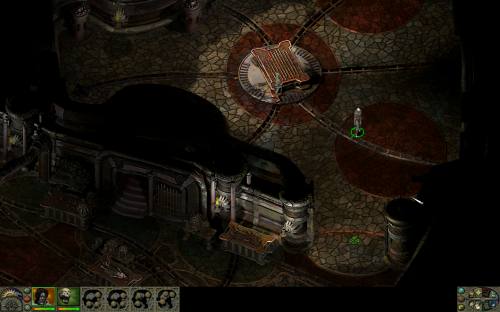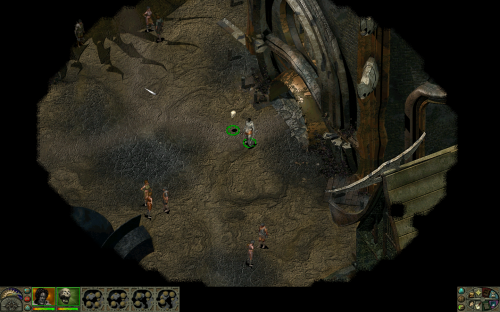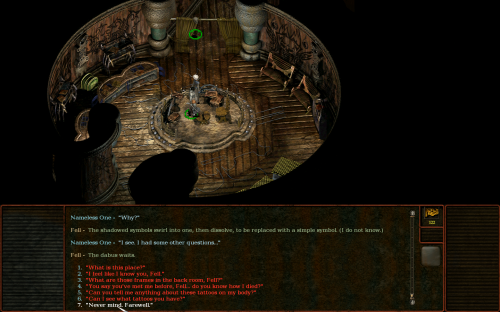I started playing Planescape Torment, finally. Then I abandoned it for about two weeks. Even better, I can’t get it to run on my main PC, so I can only play it on weekends. Expect this game to have very few and very spread out reports because of it. In this one, I’ll talk about what Planescape Torment is, how it plays and how I feel about it.
What is Planescape Torment
Planescape Torment is an Infinity Engine game, but it’s the strangest looking Infinity Engine game out there. Not knowing what it is, I’d sooner assume it uses the engine of the first two Fallout games. It’s certainly closer to those two in the art style and interface department. It’s also kind of similar to Lionheart: Legacy of the Crusader. Unlike Lionheart, which was getting very mixed and/or lukewarm reviews, Planescape is considered a classic by most people who had experience with it.
I, however, had no prior experience with Planescape Torment. For some reason, the graphical style and the user interface kept me away. The idea of a story focused game with extremely little fighting also didn’t appeal to me.
But, I bought the entire D&D package on GOG so I’m bound to play it at one point. After completing Icewind Dale and greatly enjoying it, I figured I might as well get it over with. My reasoning was that, since it’s an older game, it makes more sense to play it now, before I move on to newer D&D games which I also intend to play. I know Baldur’s Gate has probably aged worse, but there’s TuTu for that, and at least I’m more familiar with the user interface and the setting in that one.
Oh, and while we’re on the subject of settings, I’m a bit weird when it comes to that. In theory, I tend to shy away from strange, alien settings in games or movies. I say in theory, because it always happens in my head only. Once I actually do start playing a game, reading a book or watching a movie taking place in a strange setting, nine times out of ten, I end up enjoying myself. I guess it’s that tendency to shy away from different , that many people seem to have. It does manifest itself strangely, though.
In any case, Planescape Torment.
What happened
I woke up in the dusters mortuary. Apparently, I died and came back to life, with amnesia. I got through the mortuary, got a talking skull for a companion and solved a ridiculously large amount of side quests for what’s basically an intro area.
There was an encounter with the ghost of a long lost love, some backstabbing of people disguised into zombies, investigations and explorations which netted me stat upgrades as rewards and, as said, very little fighting. Well, technically, there was a lot of fighting, with a couple of enemies on each floor, but most of them were easy to deal with and some of them, like the magical armor constructs in the mortuary courtyard, I was able to get rid of without swinging my weapon a single time.
I made a character that’s supposed to be a mage, but I’m a fighter. From what people tell me, there’s an NPC somewhere that allows me to switch my class to a mage and it’s actually recommended to play as a mage, since the stat requirements with well with requirements for hidden options in conversations. I guess my priority is to find that NPC.
It will be difficult to talk about this game, because it really is very story focused and I tend to avoid talking about the story in recent articles. I just don’t think it’s an interesting thing to write about.
What I will say is that I’m having a bit of a hard time adjusting to this very different style of play. I keep leaning towards combat options and expecting dungeons and enemies to fight, when I should be talking to everyone I can and explore those options instead. I wonder if I’ll manage to get used to it.
One thing is for sure, I’m liking Planescape Torment a lot.
Now excuse me while I go and play it a bit.
What happened next
…
And I’m back.
And it’s as good as I expected it to be. I have no idea why I wasted most of the Saturday postponing my playing of this game.
During the few hours I did play, I helped a woman lost in Sigil get back to her home plane, talked to O and got him to raise my wisdom, fought a bunch of street thugs (they’re random battles throughout Sigil and kind of annoying), finally became a mage after doing a bunch of fetch quests and did a metric ton of other stuff.
More importantly, I started shifting towards a different style of play.
In most RPGs I play, I find a quest hub and then talk to everyone, taking as many quests as possible. I feel that I’m more efficient that way. I gather the quests and then go to the place where the objectives are in order to complete them.

Pictured: You start the game as a warrior. In order to unlock a different class, such as the mage in this case, you need to solve a series of quests.
With Planescape Torment, this feels almost impossible. There’s so much talk, so much story and so many quests, I just get lost tracking them all. Sure, the interface has something to do with it, since it’s rudimentary at best, but a big part of it is the sheer amount and the complexity of the quests.
So instead, I now take a quest and go solve it if I can. At least, I try to do this, but my journal is already cluttered with quests I started weeks ago, so first, I need to clean it up a bit. In any case, I probably won’t be doing much writing about Planescape. I’d hate to spoil the story for everyone, and there isn’t much outside of the story.
I’ll say one thing, do. I’ve never seen a better approach of actually playing through a story instead of just watching it unfold. I’m usually the guy that complains about games with decent stories that lack proper gameplay. Well, Planescape Torment is an incredibly story-heavy game that doesn’t lack decent gameplay. It’s just that gameplay is designed around the story. You play the story, for lack of a better term.
Dungeons and Dragons
The system is clearly still there and there’s a lot of overlap, but it’s also way different than what you’d learn to expect with games like Baldur’s Gate or Neverwinter Nights.
For one, you get to switch classes as often as you’d like, even mid battle, since some of your companions are able to do this for you.
The Nameless One just became a mage in my game, and it’s different, to put it mildly. The spells definitely have overlap, though they might be named slightly differently. Their descriptions and effects show a difference right away, though. There are no rounds or turns. Durations are in seconds and some spells expire in a completely different manner. For instance, there’s an armor spell that expires after enough damage has been dealt to your character.

Pictured: Not all quests seem to be part of the main plot. This one, for instance, had a very humorous outcome.
There are also flavor spells that fit the settings. There’s a companion you can get at an inn in Sigil that’s from a different plane, so he starts with a set of spells named and described differently, but they’re actually equivalents of common Forgotten Realms spells such as Magic Missile.
A big difference is also that you commonly get permanent stat increases by doing quests or leveling up. More importantly, Strength, Dexterity and Constitution are basically your dump stats. Intelligence, Wisdom and Charisma matter far more than the first three, because they affect conversation and quest outcomes.
Outside of that, the world of Planescape (or the multiverse) seems to actually be the same one from the Forgotten Realms, except the Prime Material plane is, I guess, different. From what I understand, Prime Material is usually the plane where the species describing the planes lives.
I probably didn’t completely figure it out yet, though.
…
A hint of the Bioware formula
Two weeks after the first word in this report was written, I’ve gotten a bit further in Planescape Torment. I’ve cleared most of the early quests and finally met up with one of the more important characters.
I’m seeing a few more things now.
For one, the game is even weirder than I thought. You can’t really die. If you do, you simply awaken in some mortuary nearby, depending on where you die. Sometimes, it even let’s you skip a part of the game if you die at the right moment. From what I can tell, there’s no penalty for dying either.
Of course, my first thought when I died the first time was to reload and that’s what I did. But then, I had some talks and did some googling and most people tell me I should simply roll with it, so that’s exactly what I’ve been doing since.

Pictured: Map of the Burried Village, where I am right now. The blueish pin at the bottom is a custom note you get to place.
The big thing I’m noticing are the first hints of the now overdone Bioware formula. Your companions have quests of their own. They aren’t really quests, but the basic mechanic is similar. As the game advances, you get to talk to your companions, discover their story and improve them as well as yourself in the process.
I don’t like the Bioware formula, because it’s way overdone these days and far too formulaic, but this is just a hint of it and it’s done really well, so it adds to the whole thing.
But what does it mean in practice?
Well, I have two companions right now, so I also have two examples.
Morte is a floating skull. His defining ability is the Litany of Curses. This is a taunt lowers enemy statistics if it works. It get’s better as you talk to to other people and, get this, learn new insults. His other trait is the fact that his primary weapon are his teeth, for obvious reason. You can buy replacement teeth and you can also upgrade his original teeth as he levels up. As I said, it’s weird.
My second companion is Dak’kon. He’s a Githzerai, one of the people living in the plane of Limbo. His race follows a specific set of teachings, which gives him access to some special spells. If you talk to him, you are able to also learn these teachings, giving you access to these spells, regardless of your class. Once you catch up to him, you get to advance both of your teachings, learning further ability as well as more about his story and his people. I’ve gotten to the seventh circle up to this point, but I’m pretty sure there’s more to it.
I know the title is A hint of the Bioware formula, but the more I’m writing, the more I realize it’s really an unfair comparison. This game is about discovery and exploration, mostly through dialog and the option to improve your companions and yourself is just another avenue for this exploration in Planescape Torment. It couldn’t be further from the overdone formula Bioware is using these days.











